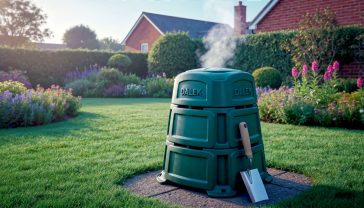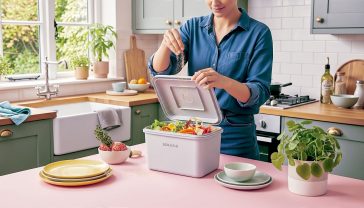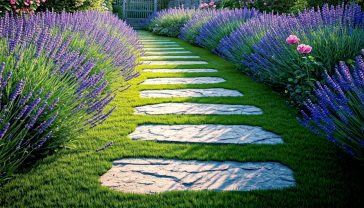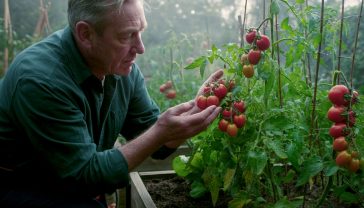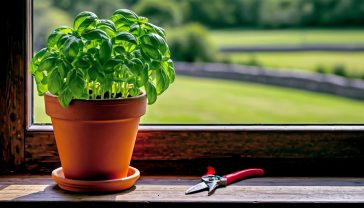DIY Gardening On A Budget: 10 Creative Ways to Save Money and Still Have a Gorgeous Garden
Want a stunning garden without the cost? This guide reveals 10 secrets for budget gardening in the UK, from growing free plants to making your own fertiliser.
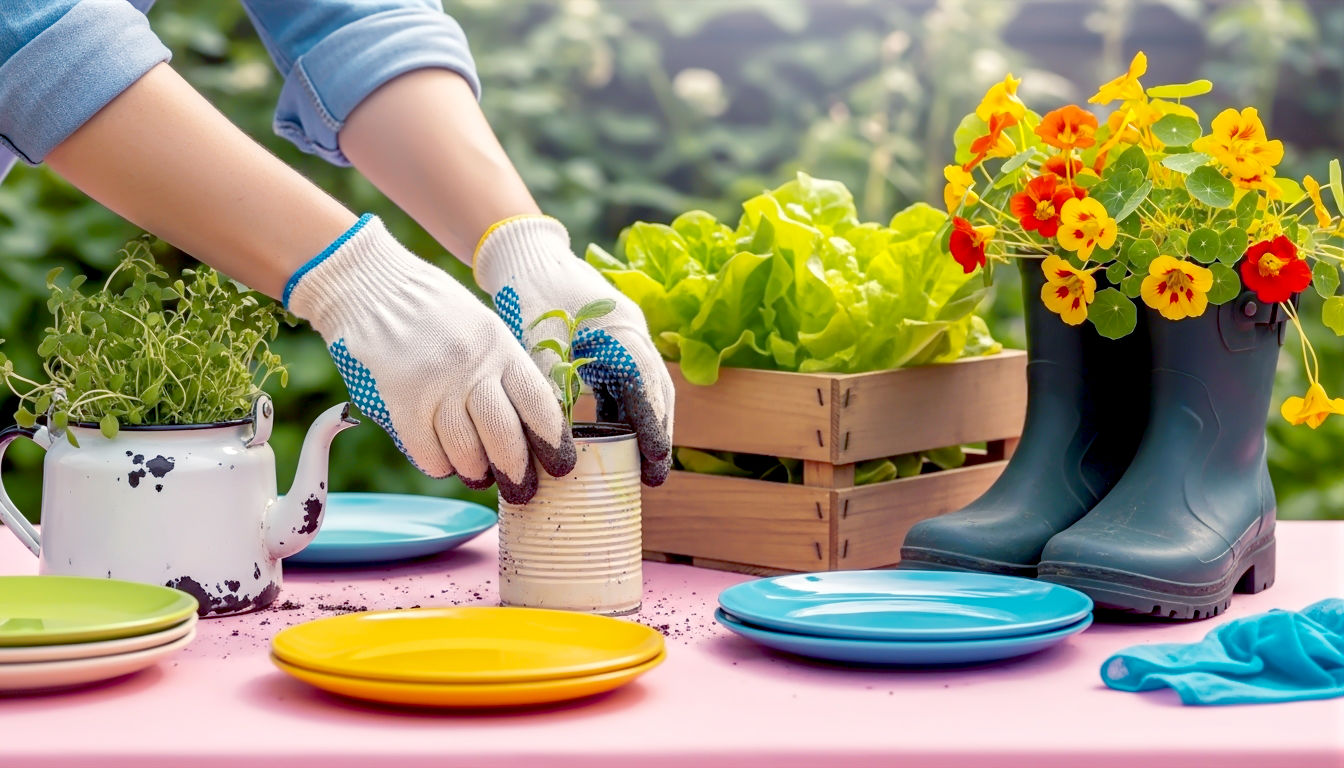
This post may contain affiliate links. If you make a purchase through these links, we may earn a commission at no additional cost to you.
We’ve all been there. You flick through a glossy magazine or scroll past a stunning garden on Instagram and a little dream takes root. You imagine yourself on a sunny afternoon, cuppa in hand, surrounded by beautiful flowers and the hum of happy bees. Then reality bites. You see the price of mature plants at the garden centre, the fancy pots, the bags of special compost, and suddenly that dream feels like it belongs to someone with a much fatter wallet.
Well, I’m here to tell you that’s a load of rubbish. Creating a beautiful, productive, and life-enhancing garden has very little to do with how much money you spend. It’s about being a bit clever, a bit creative, and rediscovering a thrifty British spirit that our grandparents would have been proud of. Think less about buying, and more about making, growing, and sharing.
This guide is your secret weapon. We’re going to explore ten simple but powerful ways to transform your outdoor space—whether it’s a tiny balcony, a scruffy lawn, or a new-build blank canvas—into a green paradise on a shoestring budget. Forget expensive shopping trips; your journey to a brilliant garden starts right here.
The Budget Gardener’s Mindset: Think Like a Plant, Not a Shopper
Before we dive into the tips, we need a quick mindset shift. Commercial garden centres are brilliant, but they’re designed to make you feel like you need to buy a finished garden. You don’t. A garden isn’t a product you purchase; it’s a process you start.
The most rewarding gardens are the ones that grow with you. They’re built on patience, resourcefulness, and the quiet joy of watching something tiny and insignificant flourish under your care. Adopting this mindset is the most important first step. See potential in an old bucket, see a future plant in a single seed, and see a free meal in a few leftover vegetable scraps. Ready? Let’s get our hands dirty.
1. Start from Seed: The Single Biggest Money-Saver
This is the golden rule of budget gardening. Buying “plugs” (tiny seedlings) or “bedding plants” (young plants ready to go) is tempting because it gives you instant results. But you pay a massive premium for the convenience.
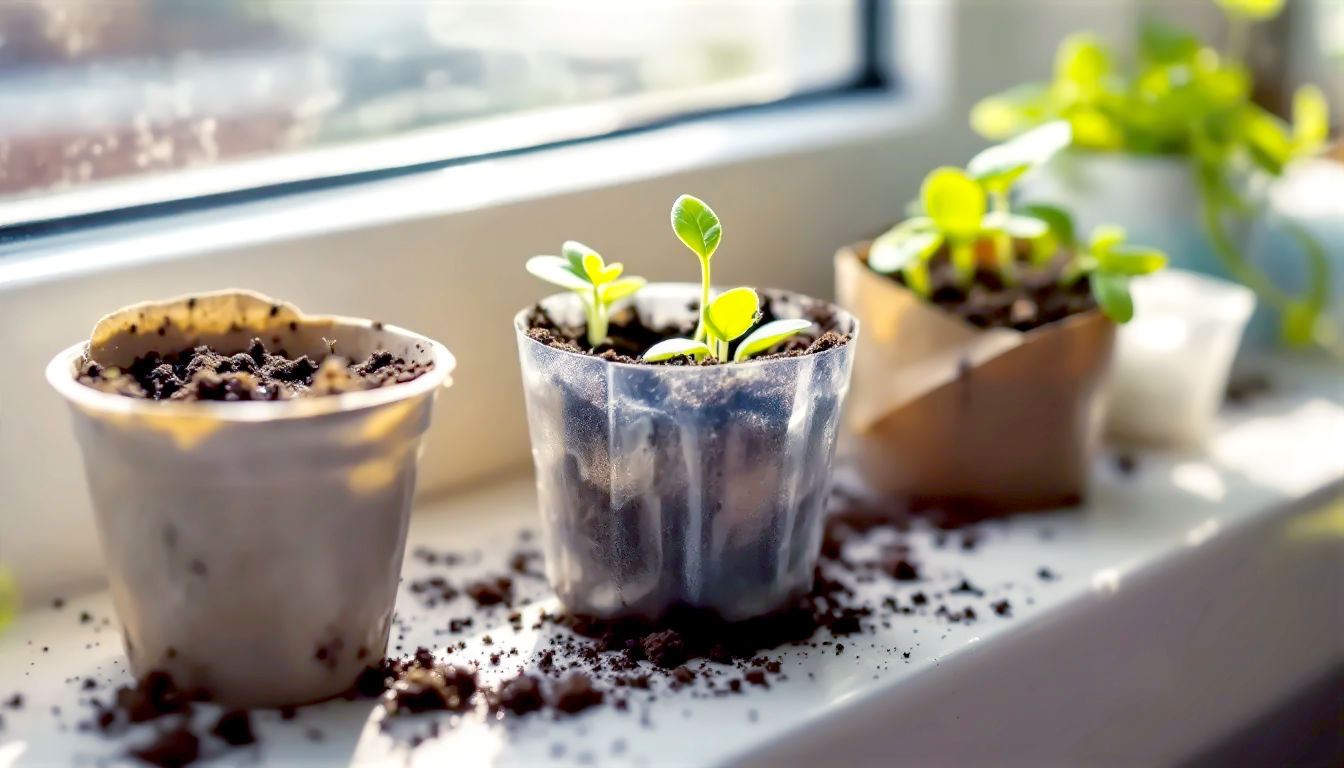
The Shocking Price Difference: Seeds vs. Plants
Let’s do some quick maths. A single young tomato plant from a garden centre might cost you £3. For that same £3, you could buy a packet of tomato seeds that contains anywhere from 20 to 100 seeds. Even if only half of them grow, you’ve got ten to fifty plants for the price of one. The same logic applies to everything from marigolds and cosmos to lettuce and beans. Starting from seed is, without a doubt, the number one way to slash your gardening costs.
Your First Seed-Sowing Kit (For Pennies)
You don’t need fancy plastic seed trays. Your recycling bin is a treasure trove.
- Yoghurt pots: Perfect for single seeds. Just poke a hole in the bottom for drainage.
- Loo roll tubes: Brilliant for seeds that don’t like their roots being disturbed, like beans or sweet peas. You can plant the whole tube directly in the ground and it will rot away.
- Plastic fruit punnets: The clear ones with lids make perfect mini-propagators to keep your seedlings warm and moist.
- Egg boxes: Great for starting off smaller seeds.
Fill your chosen container with some multi-purpose compost (we’ll get to making your own later!), pop a seed or two in, cover lightly, water, and place it on a sunny windowsill. It’s that simple.
Easiest Seeds for UK Beginners
Don’t try to grow everything at once. Start with things that are practically guaranteed to grow to build your confidence.
- Salad Leaves: “Cut-and-come-again” varieties will give you fresh salads for months from one sowing.
- Radishes: They grow incredibly quickly, which is great for impatient gardeners!
- Nasturtiums: These cheerful flowers are edible, grow almost anywhere, and their seeds are big and easy to handle.
- Marigolds: They’re tough, colourful, and help keep pests away from your veg.
- Sunflowers: The ultimate feel-good plant. Who can resist a homegrown sunflower?
2. Make Your Own Compost: Create ‘Black Gold’ for Free
Buying big plastic bags of compost is not only expensive but also bad for the environment. Yet, you can make your very own, superior version for free using stuff you’d normally throw away. Gardeners call it “black gold” for a reason—it’s the absolute best thing for your soil.
5 Crucial Things to Consider When Buying a Compost Bin
What is Compost and Why is it Amazing?
Compost is just decomposed organic matter. It’s a mix of garden waste (like grass clippings) and kitchen scraps (like veg peelings) that have been left to rot down into a rich, dark, crumbly material that’s packed with nutrients. Adding it to your soil helps it hold water, feeds your plants naturally, and brings in lots of lovely worms that keep everything healthy.
How to Build a Compost Bin for £0
You can buy plastic “dalek” compost bins, but a free, homemade version works just as well, if not better. The easiest way is to find four old wooden pallets. You can often find these for free on Gumtree, Facebook Marketplace, or by asking local businesses. Stand them on their edges and wire or screw them together to form a square box. That’s it. You have a compost bin. You don’t even need a lid.
The Perfect Compost Recipe: What to Add and What to Avoid
A good compost heap needs a balance of “green” stuff (which is wet and nitrogen-rich) and “brown” stuff (which is dry and carbon-rich). Aim for roughly a 50/50 mix.
- Excellent Greens: Vegetable peelings, fruit scraps, coffee grounds, tea bags, grass clippings, and young weeds (before they set seed).
- Brilliant Browns: Cardboard (torn up), egg boxes, scrunched-up paper, fallen leaves, straw, and small twigs.
- What to Avoid: Cooked food, meat, dairy, diseased plants, and cat or dog waste. These can attract pests and introduce nasty germs.
Just pile everything in, and let nature do the work. Give it a stir with a garden fork every month or so if you can. Within six months to a year, you’ll have beautiful, dark, crumbly compost for free.
3. Become a Propagation Pro: Get Infinite Plants for Free
Propagation sounds like something you’d do in a science lab, but it’s just a fancy word for making new plants from bits of existing ones. Once you learn this simple skill, you’ll never look at a plant the same way again. You’ll see a whole garden’s worth of potential.
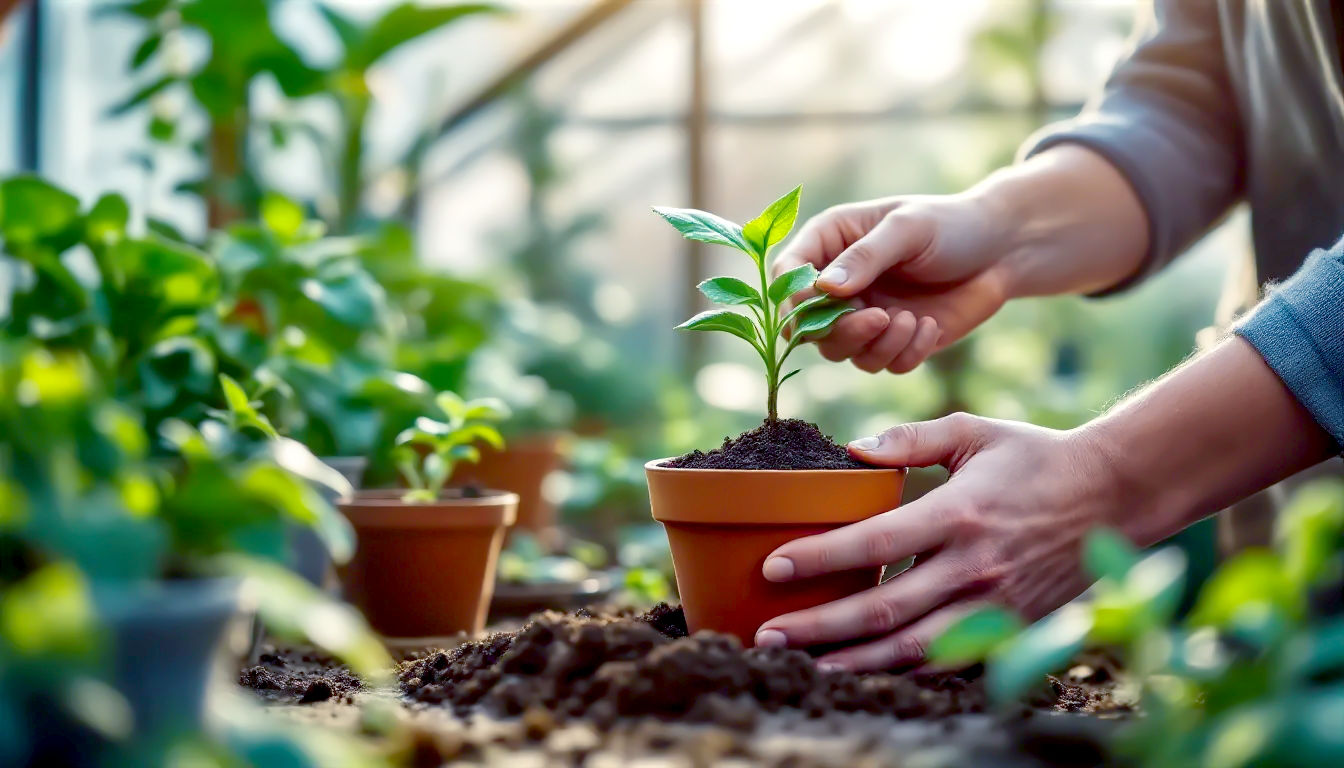
What is Propagation? (It’s Simpler Than it Sounds)
The easiest method for beginners is taking “cuttings.” This involves snipping off a piece of a plant, popping it in some soil or water, and waiting for it to grow its own roots. It feels like magic, and it’s how you can turn one plant into twenty, for free.
Taking a Cutting: A Step-by-Step Guide
- Choose a healthy, non-flowering shoot from the parent plant.
- Snip off a piece about 10cm (4 inches) long. Make the cut just below a leaf joint.
- Remove the lower leaves, leaving just four or so at the top.
- Push the bare stem into a small pot of gritty compost.
- Water it, cover the pot with a clear plastic bag (held up with a stick so it doesn’t touch the leaves), and place it somewhere bright but not in direct, scorching sun.
- Wait. In a few weeks, you should see new growth, which means roots have formed. You’ve just made a new plant!
UK Plants That Beg to be Propagated
Some plants are ridiculously easy to grow from cuttings. Ask friends and family if you can take a few snips from their plants—most gardeners are happy to share.
- Pelargoniums (often called Geraniums): The classic summer bedding plant.
- Fuchsias: Their beautiful, dangly flowers are a garden staple.
- Lavender: Who wouldn’t want more of this fragrant, bee-friendly shrub?
- Rosemary and Sage: Easily grow new woody herbs from cuttings.
- Hydrangeas: Take cuttings in spring for new shrubs.
- Succulents: Just break a leaf off, let it dry for a day, and lay it on top of some compost. A new plant will grow from the base.
4. Embrace Upcycling: Your Garden’s New Best Friend
Before you throw anything away, ask yourself: “Could I put a plant in it?” Upcycling isn’t just about saving money; it’s about giving your garden a unique, personal character that you can’t buy off the shelf.
From Kitchen Waste to Quirky Planters
Your recycling bin is your first port of call. Tin cans, with a few holes hammered in the bottom, make brilliant rustic-looking pots for herbs. Large plastic milk bottles can be cut in half to become mini-cloches to protect young plants from slugs and frost. Old colanders make fantastic hanging baskets because they come with pre-made drainage holes!
The Magic of Pallets: Vertical Gardens and More
We’ve already seen how pallets can make a compost bin. They’re also perfect for creating a vertical garden, which is ideal for small spaces. Simply stand a pallet upright against a wall, staple some strong landscape fabric inside to make pockets, fill with compost, and you can plant things like strawberries, herbs, and salad leaves in the gaps.
The Guide to Vertical Gardening: Growing Up in Britain’s Urban Spaces
Giving Old Furniture a New Lease of Life Outdoors
That wobbly old chest of drawers that’s destined for the tip? Pull the drawers out in a staggered “staircase” pattern, drill some drainage holes, and you have a stunning, multi-level planter. An old pair of wellies, a chipped teapot, a rusty wheelbarrow—they can all be given a new purpose in the garden. It adds a touch of charm and saves you a fortune on pots.
5. Hunt and Gather: Sourcing Free & Cheap Materials
Your garden doesn’t have to be built from things you buy at B&Q. The world is full of free and cheap materials if you know where to look.
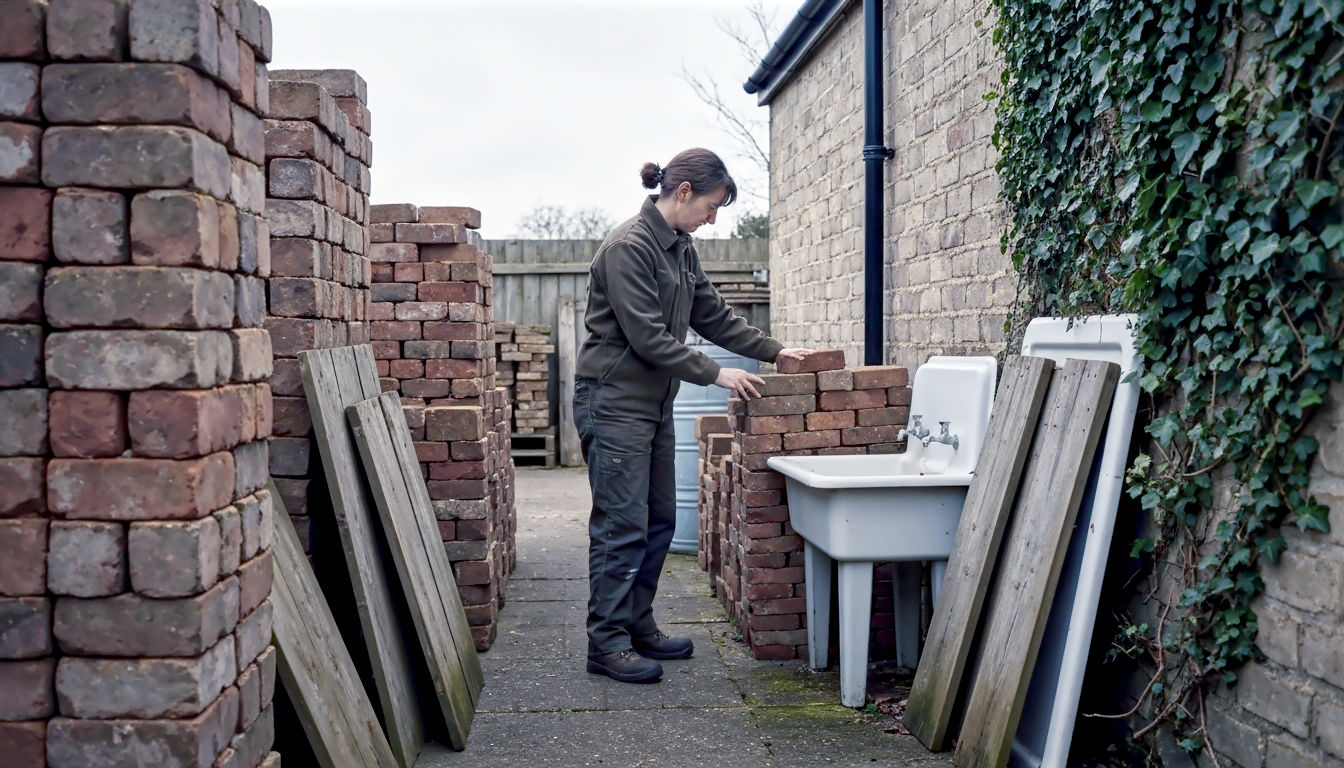
Your Digital Treasure Map: Freecycle, Gumtree, and Facebook
These websites are a budget gardener’s dream. People are constantly giving away things they no longer need. Set up alerts for words like “pots,” “garden tools,” “plants,” “paving slabs,” or “wood.” You can often find everything you need to build paths, create raised beds, or equip your shed for absolutely nothing. Facebook Marketplace and local community groups are especially good for finding people splitting up their overgrown plants and giving the spare bits away.
The Secrets of Car Boot Sales and Community Swaps
Car boot sales are brilliant for picking up second-hand tools. A bit of rust on a spade or a fork doesn’t matter—they’ll clean up just fine and will be a fraction of the price of new ones. Also, keep an eye out for plant swaps or sales organised by local gardening clubs or allotment societies. You can pick up healthy, locally-grown plants for pennies.
A Word on ‘Skip Diving’ (The Polite Way)
You often see builders’ skips full of useful things like old bricks, bits of wood, or tiles. Never just take things from a skip. It’s legally someone’s property. But there’s absolutely no harm in knocking on the door and asking politely if you can take a few items they’re throwing away. More often than not, people are delighted you can make use of it and will happily say yes.
6. Harvest the Heavens: Collect Rainwater for a Thirsty Garden
Why pay for water when it falls from the sky for free? This is especially important in the summer when hosepipe bans are common. Setting up a system to collect rainwater is simple, saves you money on your water bill, and is better for your plants.
Water Wisdom: Efficient Irrigation Strategies for Your Garden
Why Your Plants Prefer Rainwater
Tap water in many parts of the UK is “hard,” meaning it’s treated and contains minerals that can build up in the soil over time. Rainwater is naturally soft and slightly acidic, which is perfect for most plants, especially acid-loving ones like rhododendrons and blueberries.
Setting Up a Water Butt: The Easy Way
A water butt is simply a large barrel that collects rainwater from a downpipe on your house or shed. You can often get cheap or subsidised ones from your local council. They are easy to install with a simple diverter kit that fits into your downpipe. A single full water butt can hold enough water for hundreds of waterings.
No Space for a Butt? No Problem!
Even if you don’t have space for a big water butt, you can still collect rainwater. Just leave a few buckets or an old dustbin out when it’s forecast to rain. It all adds up!
7. Grow What You Eat: The Tastiest Way to Save
While a garden full of flowers is a beautiful thing, dedicating some of your space to growing your own food is one of the most satisfying and economical things you can do. The taste of a tomato picked fresh from the vine and still warm from the sun is something you can’t buy.
The “Cut-and-Come-Again” Revolution
Don’t just grow a lettuce, harvest the whole thing, and be done with it. Grow “cut-and-come-again” crops. These are plants where you can snip off the outer leaves, and the plant will keep growing from the centre, giving you a continuous harvest for weeks or even months. Loose-leaf lettuces, spinach, rocket, and many herbs work this way.
High-Value Crops for a UK Veg Patch
Focus on growing things that are expensive to buy in the supermarkets.
- Salad leaves: A bag of pre-washed salad costs a fortune and goes slimy in a day. You can grow your own for months for the price of one packet of seeds.
- Fresh herbs: A sad little plastic packet of basil from the supermarket can cost over £1. A single basil plant grown on your windowsill will give you fresh leaves all summer.
- Courgettes: One courgette plant will produce so many courgettes you’ll be forcing them on your neighbours.
- Runner Beans: Incredibly productive and easy to grow up a simple frame of bamboo canes.
8. Divide and Conquer: Multiply Your Favourite Plants
This is a classic technique that expert gardeners use all the time. Many popular garden plants, known as herbaceous perennials, grow in clumps that get bigger and bigger each year. Every few years, you can dig these clumps up and split them into smaller pieces to make brand new, free plants.
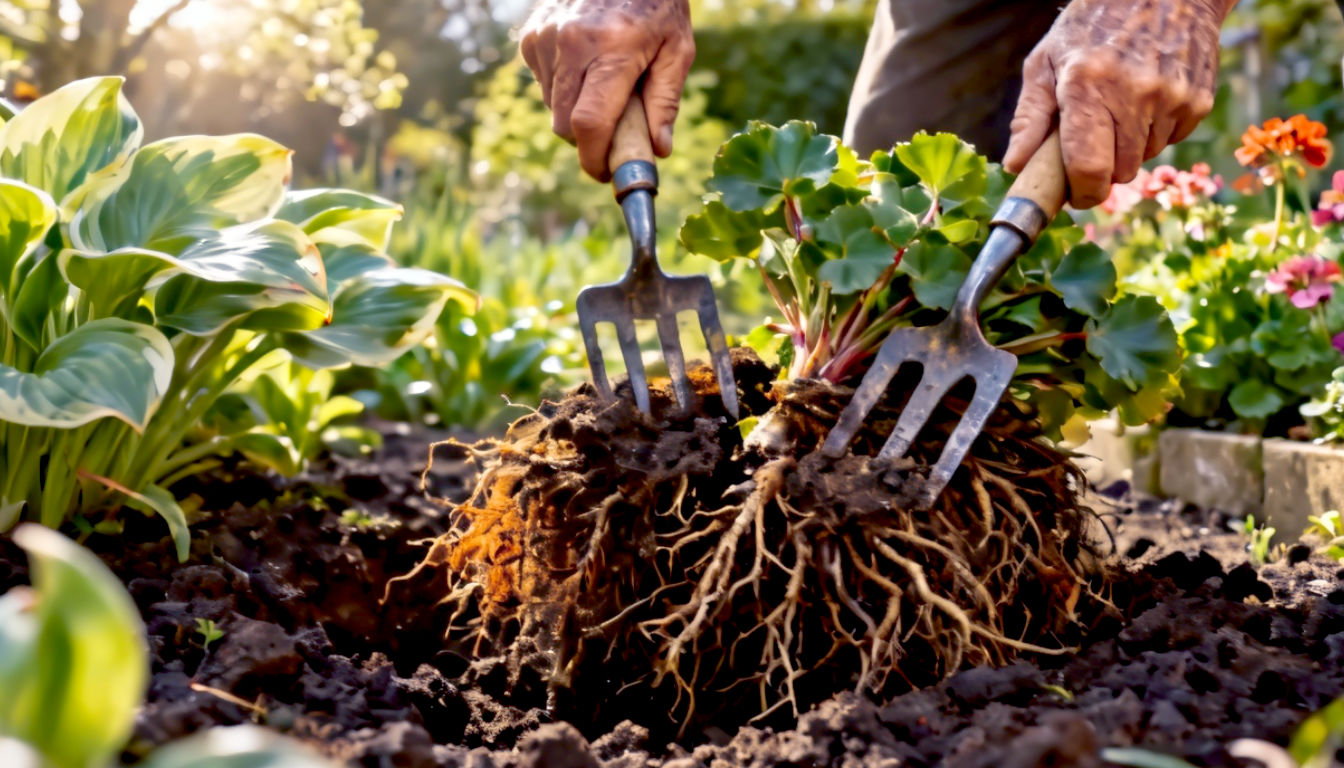
The Magic of Perennials
Perennials are plants that die back in winter but re-grow from the same roots every spring. Think of things like Hostas, Geraniums (the hardy cranesbill type, not the bedding ones), Rudbeckia, and ornamental grasses. Because they come back year after year, they are a great long-term investment.
When and How to Divide Your Plants
The best time to divide most perennials is in the autumn or early spring, when they aren’t in full flower.
- Carefully dig up the entire clump with a spade or fork.
- Shake off the excess soil so you can see the root structure.
- Gently pull the clump apart into smaller sections with your hands. For really tough, woody clumps, you might need to place two garden forks back-to-back in the middle and lever them apart.
- Make sure each new section has some healthy roots and some shoots.
- Re-plant your new divisions straight away in their new homes and water them in well.
You can use this method to fill gaps in your garden, expand your borders, or pot up the spares to give to friends.
9. Brew Your Own Plant Food: Kitchen Cupboard Fertilisers
There’s no need to buy expensive, brightly-coloured bottles of chemical fertiliser. You can make wonderfully effective, organic plant foods using things you can find in your garden or kitchen.
Stinging Nettle Tea: Rocket Fuel for Your Greens
This sounds strange, but it works! Stinging nettles are packed with nitrogen, which is what leafy green plants like cabbages and lettuce love. Find a patch of nettles (wear gloves!), chop them up, and stuff them into a bucket. Top up with water, cover, and leave it for a couple of weeks. It will smell absolutely vile, but it’s a super-potent plant food. Dilute the stinky brown liquid with ten parts water before using it to feed your plants. Comfrey leaves work just as well.
Coffee Grounds, Eggshells, and Other Kitchen Treasures
- Used coffee grounds: Slugs and snails hate them, but worms love them. Sprinkle them around plants that need a bit of a nitrogen boost.
- Crushed eggshells: A great slug deterrent and they add calcium to the soil, which is good for tomatoes and peppers.
- Banana skins: Rich in potassium, which flowers and fruiting plants love. Just chop them up and bury them in the soil near the base of your roses or tomato plants.
The Guide to Organic Fertilisers: Are They Really a Healthier Choice for Your Garden?
10. Right Plant, Right Place: The Ultimate ‘Lazy’ Saving Tip
This final tip is less of a hands-on task and more of a philosophy. One of the biggest wastes of money in gardening is buying a plant that isn’t suited to your garden’s conditions. It will struggle, look sick, and you’ll end up spending money on feeds and remedies to try and save it, before it eventually dies.
Stop Fighting Your Garden’s Nature
Take some time to observe your garden. Where does the sun fall throughout the day? Is there a spot that’s always damp? Is the soil sandy and dry, or heavy and clay-like?
Once you understand your garden’s unique environment, you can choose plants that will naturally thrive there. A sun-loving lavender will never be happy in a shady, damp corner. A fern that loves shade will scorch in a south-facing gravel patch.
Choosing Plants for Sun, Shade, and Awkward Spots
- For hot, sunny, dry spots: Think Mediterranean plants like Lavender, Rosemary, Santolina, and Sedums.
- For shady, damp spots: Think Ferns, Hostas, Foxgloves, and Brunnera.
- For heavy clay soil: Choose robust plants like Geraniums, Viburnum, and Bergenia.
By working with your garden, not against it, your plants will be healthier, stronger, and will need far less intervention and money spent on them to look fantastic.
Common Budget Gardening Blunders (And How to Avoid Them)
- The “Too Much, Too Soon” Trap: It’s easy to get excited and buy one of everything. Start small. It’s better to have a few well-cared-for plants than a jungle of neglected ones.
- Forgetting About the Soil: The foundation of any good garden is good soil. Spend your time (not money) improving it with your free, homemade compost.
- Ignoring Pests Until It’s an Invasion: Check your plants regularly for pests like aphids. Often, you can just squirt them off with a jet of water or squash them with your fingers. This is much cheaper and better than letting it get so bad you need to buy a chemical spray.
Conclusion: Your Garden is a Story You Write, Not One You Buy
As you can see, a beautiful garden is well within your reach, no matter your budget. It’s a space that should reflect your personality and creativity, not the size of your bank balance.
By starting seeds, making compost, upcycling, sharing with friends, and working with nature, you’re not just saving money. You’re engaging in a deeply satisfying and creative process. You’re building a connection with the world outside your window and creating a personal sanctuary. So go on, get out there. Your beautiful, budget-friendly garden is waiting for you.
Further Reading
For more inspiration and expert advice, check out these highly respected UK resources:
- The Royal Horticultural Society (RHS): https://www.rhs.org.uk/
- BBC Gardeners’ World Magazine: https://www.gardenersworld.com/
- The Wildlife Trusts: https://www.wildlifetrusts.org/gardening
- Garden Organic: https://www.gardenorganic.org.uk/

